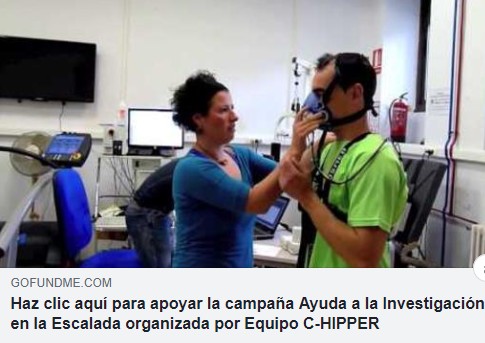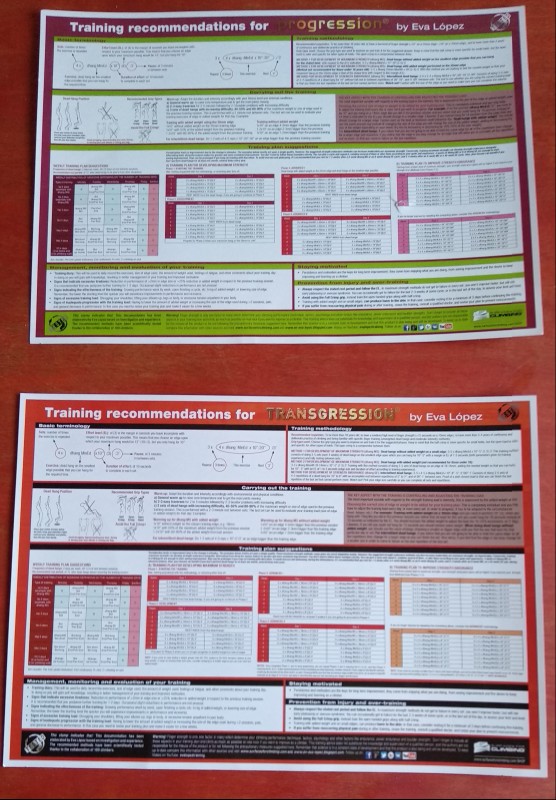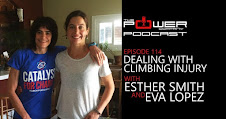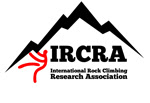Versión en español
 Do you some days get to the gym only to find that you don't feel like training today?
Do you some days get to the gym only to find that you don't feel like training today?Are you tired even at home, although you have not made any physical effort yet?
Is it not only that you don't feel like doing your chores, but also that you lack the energy to perform them? Perhaps you feel apathy, lack of interest, sleepiness, to the point that even walking can be challenging and those coffees that usually are so helpful don't have the desired effect anymore... Maybe your head hurts, and your resting heart rate is higher than usual. You try to find the cause of such fatigue, but to no avail...
Gathering all the willpower you have left, you put your climbing shoes on and start climbing. But the nightmare is still going on and, even warming up, your arms get pumped in the easiest sections. When a hard move comes, well, you just don't have that kind of power. If you are at the gym and try to do some boulder or strength exercise your heart rate spikes while doing things that you remember being easy before. To top it all, the sweat on your hands makes you slip off the holds all the time...
Do these symptoms ring a bell? Perhaps you have experienced similar circumstances, "incidentally" associated to really hot days?
 Well, you are right, those symptoms are due to heat, and heat-induced fatigue.
Well, you are right, those symptoms are due to heat, and heat-induced fatigue.For life to go on, we need to keep our internal (rectal) body temperature between about 36,1ºC and 37,8ºC. (Córdova 1999).
During exercise, the rate of metabolic heat production goes up, so that if this heat surge is not balanced by the rate at which we dissipate it, our internal temperature can get too high, and this is highly correlated with a decrease in sport performance. Exhaustion and inability to continue an endurance exercise are reached when internal body temperature goes between 39ºC and 40,3ºC, according to González-Alonso et col. (1997).
We also have to realize that for a given intensity, the higher the temperature, the higher the metabolic and cardiovascular stress will be, and that this will contribute to exacerbate our sensation of fatigue:
When it's hot, there is a lot of blood flowing towards the skin instead of the muscles used in the exercise, a higher oxygen consumption, an increase in muscle lactate, heart rate and sweating, and a higher spending of muscle glycogen; all in all, greater energy production (Willmore and Costill, 2007).
It's believed that this fatigue and the changes inside our body can be caused by the direct effects of hyperthermia over the central nervous system, and are a defense mechanism of the body, that works like a "fuse" which prevents the athlete from keeping on producing heat and suffering heat-induced injury, heat stroke or even death (Terrados et col., 2004).
Regulation of body temperature resides in the hypothalamus and it works in a similar fashion to our home's thermostat: when body temperature goes up, our central and peripheral thermoreceptors send signals to the hypothalamus and the cerebral cortex to voluntarily stop exertion, to get further from the heat source, or to boost our heat loss through vasodilation and metabolic activity (Terrados et col., 2004).
What can we do to combat the negative effects of heat?
 It is vital to drink enough.
It is vital to drink enough.For every liter of water lost, heart rate increases about 8 bpm. Less blood gets to the skin, so heat dissipation is compromised, and central body temperature goes up 0,3ºC for each liter of water lost (Coyle, 1994). It has been shown that a loss of just 1% of body weight (0,7kg for a 70kg athlete), causes a 5% reduction in our maximum time doing a continuous endurance exercise.
Also, it's been suggested that hydration with a sugary or isotonic drink (6% sugar), improves the thermoregulatory system (Below, 1995).
The method to follow would be like this:
- drinking about 1 liter of water during the hour previous to competition, about four times 15 minutes apart, 150-250ml of sugary drink each time,
- every 15' during a training session or a climbing day,
- and after training, taking 150% of the body weight lost, in 2-3 times starting with a big one (800-1000ml), and following with smaller ones during recovery (200 ml/15 minutes).
It also seems that adding 5,6g/l of sodium (Shirreffs, 2000) improves body liquid recovery.
A different technique that can be used is precooling. González-Alonso et col.(1999) observed that cyclists who lowered their internal temperature to 36ºC thanks to having been immersed in cold (17ºC) water for 30', were capable of doing 63 minutes of pedaling, in contrast to the 28 minutes that lasted those who were immersed in hot water for 30', and as such had an internal temperature of 38,2ºC. Other studies suggest that the same effect can be obtained by cooling all the body with the exception of those muscles used in the exercise, to avoid vasoconstriction that can compromise performance (Cotter et col., 2001)
 Gorostiaga (2004) puts forward the following method for endurance training: doing a 45' precooling before the exercise, that can be performed in two ways: 1) staying inside a room with very cold (3-4ºC) air conditioning or being covered with ice, but using warm clothes over the muscles that are important for the exercise, or 2) staying up to the neck into cold water.
Gorostiaga (2004) puts forward the following method for endurance training: doing a 45' precooling before the exercise, that can be performed in two ways: 1) staying inside a room with very cold (3-4ºC) air conditioning or being covered with ice, but using warm clothes over the muscles that are important for the exercise, or 2) staying up to the neck into cold water.Even though water immersion is recommended, it would seem reasonable to keep out of the water the muscles that will be more needed for the exercise (like keeping your legs out of the water if you are going to run).
Keeping a low body weight will also help dissipating heat. Smaller people can get rid of excess heat easier than bigger and heavier ones, even if they have the same relative amount of body fat. This is because their body surface to body mass ratio is higher. This allows them to dissipate proportionally more heat than bigger individuals (Marino et col., 2000). This said, reduced body fat also helps in conveying heat to our surroundings, because an excess of fat increases the insulating capacity of the skin and slows heat conduction towards the surface (Mc Ardle et col., 1990).
Lastly, prevention and carrying out a good adaptation process to heat will yield good results. The greater benefits will take no more than 3-5 days to become apparent and will be fully developed in about 2 weeks:
We will start to sweat earlier, the sweat will be less thick and higher in volume, our resting heart rate will drop, we will spend less glycogen at a given intensity, and the flow of blood towards the skin will improve. The first changes explain why when we are adapted to heat we need to drink more, not less.
Heat adaptation doesn't mean the athlete getting used to training while dehydrated. To this day there is no evidence that humans can develop adaptations to dehydration.
 To obtain a good heat acclimation the following guidelines are in order:
To obtain a good heat acclimation the following guidelines are in order:- Avoid intensive anaerobic training during the first week of heat adaptation (González Alonso et col., 1999)
- Exposing oneself to heat for the whole day is more effective than just enduring it while training and spending the rest of the time in air conditioned places. We can take advantage of a/c while sleeping, and during recovery periods. (Noakes: "Exercise in the heat" in "Clinical Sports Medicine", Brukner and Khan, 2007)
- If we want to perform in a hot environment, we should train with heat for at leas 2 weeks while we make sure we are well hydrated and observe the precautions needed to avoid heat stroke. The same goes if the environment is both moist and hot.
-During the first days of adaptation, it's advisable to carry out the more intensive training sessions early in the morning or late in the evening, and reserve the hottest hours of the day for lower intensity sessions (Gorostiaga, 2004). Or we can reduce the intensity in this first phase to 60-70%, and progressively increase it, training at higher loads with high temperature for another 5-10 days until we are fully adapted (Willmore and Costill, 2007).
Unfortunately, it seems that the effects of acclimation are lost if we don't train under hot conditions for 2 to 4 weeks, so...
don't get all depressed if you return home from climbing at that high, cool crag, only to find that you will have to endure once again that feeling of slowly being baked.
Patience.
SOON: Recommendations for Climbing in the Heat
REFERENCES
- Below P.R., Mora-Rodríguez R., González-Alonso J. and Coyle E.F. (1995). Fluid and carbohydrate ingestion independently improve performance running 1 h of intense exercise. Med Sci Sports Exercise. 27:200-210.
- Cordova A. (1999). La fatiga muscular en el rendimiento deportivo. Madrid. Edit. Síntesis
- Cotter J.D., Sleivert G.G., Roberts W.S. and Febbraio M.A. (2001) Effect of pre-cooling, with and without thigh cooling, on strain and endurance exercise performance in the heat. Comp Biochem. Physiol A Mol. Integr. Physiol 128, 667-677.
- Coyle E.F. (1994). Fluid and carbohydrate replacement during exercise: how much and why?. Available online http://www.gssiweb.com
- González-Alonso J.; Teller C., Andersen S.L., Jensen F.B., Hylding T. and Nielsen B. (1999). Influence of body temperature on the development of fatigue during prolonged exercise in the heat. J. Appl. Physiol. 86(3): 1032-1039
- Gorostiaga E. (2004). Adaptación al ejercicio en ambiente caluroso. Comité Olímpico Español.
- Marino F.E., Mbambo Z., Kortekaas E., Wilson G., Lambert M.I., Noakes T.D., Dennis S.C. (2000). Advantages of smaller body mass during distance running in warm, humid environments. Pflugers Arch. 441, 359-367.
- McArdle W.D., Katch F.I. and Katch V.L. (1996) In: Exercise Physiology: energy nutrition and human performance. Ed. D. Balado, Maryland, Willians and Wilkins
- Noakes T. (2007). Exercise in the heat. In Brukner P. and Khan K. (Eds). Clinical Sports Medicine. 3rd edition. (pp 888-897) Australia McGraw Hill.
- Sawka M.N. and Coyle E.F. (1999): Influence of body water and blood volume on thermoregulation and exercise performance in the heat. Exercise Sport Science Reviews, 27:167-218
- Shirreffs S.M., Taylor A.J.and Leiper J.B. (1999). Post-exercise rehydration in man: effects of volume consumed and drink sodium content. Med. Sci. Sports Exerc. 28, 1260-1271.
- Terrados Cepeda N., Mora Rodríguez R. and Padilla Magunacelaya, S. (2004). La recuperación de la fatiga del deportista. Madrid. Edit. Gymnos.
- Willmore J.H. and Costill D.L. (2007). Physiology of sport and exercise, 3th edition. Human Kinetics.






 https://orcid.org/0000-0003-0304-5290
https://orcid.org/0000-0003-0304-5290







